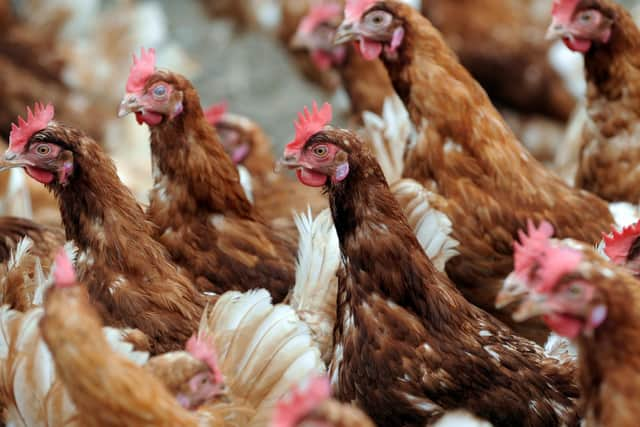If we’re serious about the climate crisis, being cruel can no longer be an option - Philip Lymbery
Stark warnings indeed, issued in the run-up to last year’s UN Climate Change Conference hosted in Glasgow, but what does it have to do with being kind to animals? Well, everything.
Raising animals intensively for food is the biggest source of animal cruelty on the planet; it also happens to be a major emitter of greenhouse gases. Food is responsible for up to 37 per cent of global greenhouse gas emissions. As it is, the livestock sector alone produces more greenhouse gases than the direct emissions from all forms of transport worldwide.
Advertisement
Hide AdAdvertisement
Hide AdIn addition to the well-publicised problem of methane emissions from ruminants, there is another big issue: the growing of feed for intensively-reared animals on mega-farms, which causes climate emissions of nitrous oxide by using fertilisers. Nitrous oxide is the most aggressive of the greenhouse gases – 300 times more potent than carbon dioxide, emissions of which have increased by almost a third during the period of agricultural intensification.


Stopping runaway climate change also requires us to address the decline of the natural world around us, which means protecting biodiversity. As nature retreats, so she stops providing essential services such as pollination, soil replenishment, and carbon sequestration, making tackling the climate crisis even harder, let alone the business of producing food for a growing population.
As a lifelong naturalist who lives on a farm, I see the impact of intensive food production on biodiversity every single day. I am acutely aware of how cutting down forests and ripping out hedges the world over removes vital habitat for wildlife.
As a passionate animal welfarist, I also know just how miserable life is for animals on these industrial farms. I remember visiting a cattle feedlot for ‘battery beef’ in the American Midwest. A thousand cattle stood motionless in dusty paddocks, not a blade of grass in sight. You’d have thought it would be noisy, but instead there was an eerie hush. It was like a hospital ward, the uncomfortable silence broken only by the odd cough, sneeze, or wail. Fully grown cattle and tiny calves were standing in the fierce Nebraskan summer sun with no shade, desperately trying to lie in each other’s shadow.
I’ve visited many such farms in Britain too, including cage farms for egg-laying hens. I remember being overwhelmed by the sight of row after row of cages stacked on top of each other. The noise was deafening. Through the gloom, you could make out the frantic heads of hens flicking in and out of cage fronts, the only sign that the wire prisons were inhabited by living creatures.
As we look to transform food systems for sustainability, we will have to approach farm animal welfare differently. Rather than looking at animals in their confined environment and trying to work out the component parts of what they need, we should be looking to put animals back into the environment. That way, they are provided naturally with what they need for a healthy, happy life.
To me, laying hens provide the classic example of how looking at animals in their confined environment resulted in the wrong answer.
Towards the end of the last century, some of the best animal welfare scientists in the world studied every facet of a hen’s needs and wants. They considered what hens needed in their confined environment for better welfare. What did all that science come up with? The enriched cage: an abysmal, minimalist approach to animal welfare leading to the birds being locked in cramped confines with rudimentary clutter aimed at satisfying complex behaviours such as nesting, dustbathing, and so on.
Advertisement
Hide AdAdvertisement
Hide AdWhat was missing was a common-sense approach that actually, chickens shouldn’t be in a cage of any description. Instead, they should be in the environment.
What the scientific team overlooked was that putting farmed animals back into the environment as part of mixed, rotational, nature-friendly farming would naturally provide the birds with the essentials for genuinely good animal welfare. The ability to peck and scratch and flap. To enjoy fresh air and sunshine.
It was a salient lesson in why we need to move away from a reductionist approach to animal welfare set on modest improvements in an impoverished system.
Instead, we need positive, visionary, expansionist approaches to animal welfare, where the aim is not only to keep animals free from hunger or disease, but to give them the freedom to enjoy life.
In the battle for the planet then, showing kindness could be a masterstroke: restoring animals to the land as part of regenerative, nature-friendly farms.
The joyous thing is that when animals are returned to the land like this in the right way – as rotational grazers or foragers as part of nature-friendly, regenerative farming – amazing things happen. They can express their natural behaviours – running, flapping, grazing – making for happier animals with better health too.
Regenerative farming cuts reliance on chemical pesticides and fertilisers, reducing costs to farmers and creating a varied landscape bursting with wildflowers that lure back pollinating insects like bumblebees, as well as providing seeds and insects for birds and other wildlife. Rivers benefit from cleaner water, stronger riverbanks, and less flooding. Riverbeds no longer silt up, so trout and other fish have habitats in which to spawn.
All of which goes to show that in being kind to animals, we are looking after ourselves better too.
Advertisement
Hide AdAdvertisement
Hide AdPhilip Lymbery is Global CEO of Compassion in Farming International, a former United Nations Food Systems Champion and author of Farmageddon: The True Cost of Cheap Meat and Dead Zone: Where the Wild Things Were. Philip’s new book Sixty Harvests Left: How to Reach a Nature-Friendly Future is out now and available from all leading bookstores. He is on Twitter @philip_ciwf
Comments
Want to join the conversation? Please or to comment on this article.